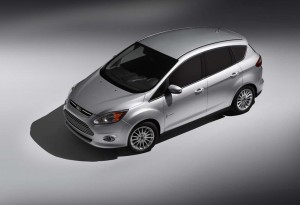
Ford cut the mpg rating of the C-Max Hybrid while also giving up to $550 to owners as a "goodwill" gesture.
Ford Motor Co. will reduce the fuel economy rating of its popular C-Max Hybrid by about 10% to better reflect what often-frustrated buyers have been experiencing in the real world, and it will offer owners as much as $550 as a “goodwill payment” to cover higher-than-expected fuel costs.
The hybrid version of the C-Max has been the center of controversy since Ford started advertising a 47 mpg rating for the “people mover.” That has triggered significant criticism – and several lawsuits from those who claim the numbers don’t reflect real-world experience. But the C-Max Hybrid is by no means alone.
The Environmental Protection Agency, which is charged with overseeing federal fuel economy regulations, is expected to announce revisions to its testing and labeling procedures to acknowledge the mileage gap many of the latest vehicles – especially those using hybrid and other advance powertrain technologies – suffer from.
“We’re seeing more variability in hybrids than in regular vehicles,” noted Ford’s global product development czar Raj Nair during a Thursday afternoon news conference.
The technology, which combines both a conventional gas engine and an electric motor under the same hood, is sensitive to a range of factors that can significantly impact mileage. That includes altitude, driving behavior, even the weather. If the temperature falls from 70 to 40 degrees, noted Nair, mileage can decline by as much as 5 miles per gallon.
(Click Here to read about Ford’s fix for improving hybrid mileage.)
But the EPA’s testing procedures also don’t help. The complicated formula can result in the same fuel economy estimates for distinctly different vehicles – such as the sleek Ford Fusion Hybrid and the boxier, heavier C-Max Hybrid. While Ford will maintain the 47 mpg sticker for the sedan model, the people-mover will now be rated at 43 mpg.
The actual difference is relatively modest in everyday driving, suggested Nair, noting that at 43 mpg a vehicle would only use 0.2 gallons more fuel than a model getting 47 mpg. For the average motorist driving 15,000 miles a year, that would work out to about 30 gallons more, or about $120 annually.
Nonetheless, Ford is hoping to take the sting off for owners angered by the lower mileage numbers with a cash “goodwill payment” of $550 for those who purchased the 2013 C-Max Hybrid, and $325 for those who leased.
(Ford wants a new way to measure mileage. For more, Click Here.)
Nair could not say precisely how much that will cost Ford. About 32,000 will receive the payments but he didn’t have a split between lease and purchase customers. The potential cost would thus run somewhere between $10,400,000 and $17,600,000.
That could be significantly less than what Ford might have to spend if it were to lose several lawsuits that have been brought against the maker for falling short of EPA mileage labels with the C-Max and Fusion Hybrids.
One case, filed in May by Massachusetts C-Max owner, Marianne Cibeu alleges she was getting only 32 mpg. “Plaintiffs purchased a Fusion Hybrid or C-Max Hybrid, only to be stuck with under-performing, less valuable vehicles that inflict higher fuel costs on their owners,” the lawsuit alleged. Meanwhile, two California law firms have consolidated their own legal actions accusing Ford of making “false and misleading” mileage claims.
Ford is by no means alone. Early last year, Honda landed in hot water when a small claims judge in Southern California sided with a frustrated owner who wanted the Japanese maker to reimburse her for added fuel costs on her Civic Hybrid and the likely lower trade-in value. She initially won her case, though Honda eventually got the small claims court verdict reversed, but it went on to settle a separate class action suit over lower-than-expected mileage.
The EPA has repeatedly tried to adjust its testing procedures to cope with the mileage problem, most recently in 2008. The agency is expected to address the mileage gap issue on Friday to try to make its test results better reflect what consumers should expect.
Ford, meanwhile, says it is taking steps to reduce the variability in mileage hybrid owners experience. Last month, it announced software changes that will do such things as let the C-Max Hybrid continue operating in electric-only mode at higher speeds. And the software will keep the vehicle’s wind-cheating active grille shutters closed under more conditions.
On Thursday, product development chief Nair also announced some hardware changes for Ford’s 2014 hybrid models, including modifications meant to improve aerodynamics, as well as changes in the driveline to improve fuel efficiency.

There are two issues here that cause issues with mpg ratings based on the EPA testing cycles:
1. There is no known means to simulate the “typical” mpg customers will experience because driving style alone can vary the mpg by up to 30%.
2. Changes in ambinet weather conditions and road surfaces can change mph by 20%.
Thus there is no possible means to accurate predict what a “typical” driver will experience for mpg be it with a gas, Diesel or hybrid vehicle. Hybrids and EVs are the worst possible vehicles to rate due to their operational modes.
Lawsuits against a car maker who can prove that their vehicle delivers the EPA test cycle mandated mpg rating, should be dismissed. The car maker should not be responsible for the variations in driving styles or ambient conditions. If consumers are unhappy with their mpg results they should be complaining about the EPA mandated mpg certification test cycle.
About the best an auto maker could do is report the minimum projected EPA rating, which would also be a nightmare unless the entire mpg rating system is again overhauled and consumers are EDUCATED to the changes and the influence that their driving style has on mpg ratings. The U.S. judicial system should not entertain the frivolous lawsuits from siren chasers.